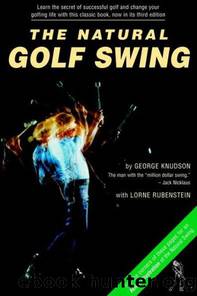The Natural Golf Swing by Knudson George & Rubenstein Lorne

Author:Knudson, George & Rubenstein, Lorne [Knudson, George & Rubenstein, Lorne]
Language: eng
Format: epub
Tags: Sports & Recreation, General
ISBN: 9781551994826
Publisher: McClelland & Stewart
Published: 1988-01-01T07:00:00+00:00
5. The Starting Form
AFLAWLESS starting form gives us the best opportunity of making a proper swing motion. We set up in balance because we want to swing in balance. A balanced starting form gives us that chance. When we connect it to a balanced finishing form we ensure the desired result.
A balanced starting form accomplishes many good things. It sets the tone for the motion, for one, while promoting feelings of simplicity and freedom.
The starting form is totally within our control. Weâve gone a long way toward ensuring a positive result if we get it right.
Before we get into the components of the starting form, Iâd like you to look at the illustration of the starting form that begins this chapter. The impression is of a golfer who is relaxed yet alert, at ease yet full of vitality. Thereâs a feeling of being ready, in a âgoâ position. I have an impression of strength when I see golfers who are set up like this. They resemble boxers, or tae-kwon-do experts. Theyâre prepared, ready to move. It seems that you couldnât budge them, theyâre so stable, but that at the same time theyâre like cats, ready to spring loose. You can sense the energy coursing through their bodies.
By contrast, a golfer who is slumped over appears weak and sluggish. You could easily push him over. His body language speaks of withdrawal; heâs given up before he starts. Thereâs no feeling of intent, no sense of power. Heâs as sluggish as the other fellow is alive.
Keep the accompanying illustration in mind as you study the starting form. Weâre setting you up to make an aggressive move, an athletic move, one full of purpose and direction.
Letâs look at the starting position in detail. Weâll break it up into its components: target awareness, grip, stance in relation to target, alignment in relation to target, ball location relative to the body, and posture.
Download
This site does not store any files on its server. We only index and link to content provided by other sites. Please contact the content providers to delete copyright contents if any and email us, we'll remove relevant links or contents immediately.
Golf is Not a Game of Perfect by Bob Rotella(1031)
Final Rounds by James Dodson(976)
Letters to a Young Writer by Colum McCann(967)
Caddyshack by Chris Nashawaty(877)
My Life in and out of the Rough by John Daly(866)
Back Spin by Harlan Coben(836)
Chasing Greatness by Adam Lazarus(824)
The Caddy's Cookbook by Tripp Bowden(824)
Alice Cooper: Golf Monster by Alice Cooper(815)
The First Major by John Feinstein(805)
The Sorceress by Michael Scott(799)
How Champions Think: In Sports and in Life by Bob Rotella(792)
No Limits: My Autobiography by Ian Poulter(779)
Every Shot Counts by Mark Broadie(774)
Carl Hiaasen by The Downhill Lie(768)
Scott, Michael - The Sorceress by Scott Michael(754)
Golf and Philosophy by Wible Andy(737)
The Flexible Golf Swing by Roger Fredericks(723)
Hank Haney's Essentials of the Swing by Hank Haney(708)
